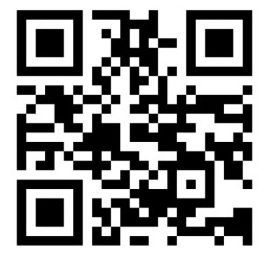Books not bullets
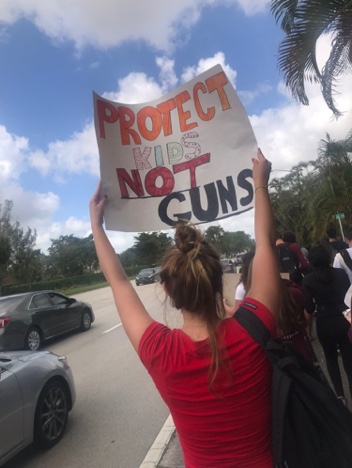
Photo Credit: Zoe Petrucci
Student action continues as teenagers start walkouts and other protests to demand change.
Think about your morning. What did you do? Most likely you woke to the blaring of an alarm clock or shouts from parents or siblings. Maybe you’re thinking about that math test second period or worrying about seeing that one friend who you’re currently fighting with over a dumb comment you made. Meanwhile someone else is loading a gun.
Walking through the school doors, you see the faces you look at everyday but don’t really see. You look through your classmates because you have things on your mind that currently, to you, seem like life or death situations. Are you going to be late? How are you going to finish that essay due at the end of the day? You sit down at your desk in the middle section of the classroom, slightly to the right, and take out your binder or pencil or calculator or computer. Paying attention is hard as you feel your eyelids getting heavy from the nominal four hours of sleep you received last night due to college essays and SAT studying. Just as your eyes close and begin to dream, the sound of gunshots down the hall snap you into a nightmare.
Regrettably, these scenes are becoming more of a reality for hundreds of students and teachers across the country. As the federal government is effectively staying silent on the issue, children are being killed in a place that is meant for them to feel safe. Kids as young as 7-years-old now have to learn what a gun is, what it does, and what to do if an active shooter enters their school.
Listening to the news with my family on these typical school mornings, I think to myself, “This could never happen to me. I live in Glen Rock New Jersey. The most eventful thing that ever happens here is that some stupid kid gets caught selling or smoking pot”. This was the same thought process of the victims and witnesses of these school shootings. Just like me and you, they had worries before that fateful day. Just like us, they thought about upcoming tests, drama, college, crushes. The difference is our days went on while some of theirs ended or were completely and irreversibly changed for the rest of their lives.
February 14 began as just a normal day for Parkland junior Sam Schneider. He and his sister Ava made their way to Marjory Stoneman Douglas High School and went their separate ways as the day began.
Sam is in a program called dual enrollment which allows high school students to take college courses for both high school and college credit instead of AP courses. This Valentine’s Day, Sam went home early because where he was supposed to have AP US History, he now has a free period.
Usually during these free periods, Sam puts away his phone and works out or plays basketball. He didn’t look at his phone until returned home later that afternoon. As he checked his phone, his eyes wandered to a text from his mother and stopped in his tracks.
“Shooting at school”.
Sam’s initial thoughts were unconvinced. Maybe the school conducted a routine evacuation drill and his sister confused it for something real. None of his friends had texted in any of their group chats about it. It must’ve been a false alarm.
When he turned on the TV, however, his thoughts changed. On every news channel, headlines read “Active Shooter” or “Shooter at large at Marjory Stoneman Douglas High School”.
Meanwhile, sophomore Zoe Petrucci, at neighboring Taravella High school 5.3 miles away, was just leaving school when her boyfriend told her about a shooting that occured at Parkland. Zoe didn’t realize the severity of the situation because her school only had a false alarm gun scare. She didn’t think too much of what was going on until later when she too had checked the news and realized people were injured and dead.
Sam’s thoughts now changed into disbelief. How could this be happening at his school? A place where he spent every week, where all his friends and teachers were. All he wanted to do was text his friends and his sister and make sure they were all okay and safe from harm, but he couldn’t. The drills at his high school taught Sam that the tiniest ring from a cell phone could trigger the attention of the shooter. So, he was stuck agonizing for what seemed like hours, trying to find out if his loved ones were safe.
During this process, the news going on in the background made his gut wrench even more as headlines read “Two confirmed deaths at Parkland shooting”. These numbers rose as time went on.
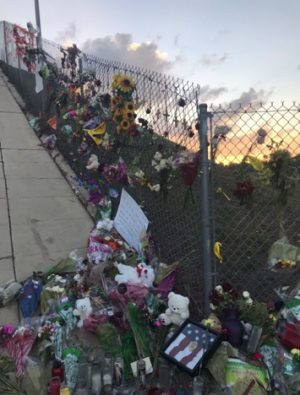
The memorial brought different communities together and grieved for the souls lost.
Eventually, he got in contact with his sister and most of his friends who assured him they were safe.
“At a certain point you understood that they had either gotten out or they had been shot at the school,” he said.
The days and weeks after the shooting were a difficult time. Zoe had been told someone she had known, Nicholas Dworet, was one of the victims on that fateful day. He was unidentified at first but was later added to the list of names. Zoe and Nick met through mutual friends and were not very close, but said that he was very outgoing and always had something nice to say about everyone.
As he entered the memorial, Sam looked around at all of flowers, notes, stuffed animals, pictures. Seeing pictures of classmates he would never see in the hallway again hit Sam hard and he gravitated towards his friends during this time. At the vigil, the memorial for the seventeen victims, parents and friends spoke of lost loved ones. At this point, Sam had broken down and cried, something he rarely does in public. One of the victims, Helena Ramsey, sat next to Sam in chemistry last year. Even though they weren’t great friends, he felt a connection with her and the other victims at the school.
Zoe was also at the vigil, standing somewhere near Sam although the two didn’t yet know each other. She felt that being at the memorial brought her closer to many people whom she would not have known or talked to before this. It was a time for both Sam’s, Zoe’s, and other surrounding communities to be together and grieve for those who their state had lost but will always remember.
Sam and his friends visit the memorials often, not to remember the incident because they will never forget, but to pay their respects and remember who the victims were and the amazing lives they led which they can’t lead anymore.
Marjory Stoneman Douglas High School had closed after the shooting to give the students time to breathe and process. But after two weeks, Sam and his sister finally returned to school. His sister Ava, who had been at the school when the shooting occurred, was doing better, but they were both anxious of how the day would go. When Sam entered the school, he walked down the halls and saw security guards flanking the hallways. All the guards had rifles. It made Sam think: would this be what his life was like until he graduated next year? To him, it was unacceptable to have the very weapon that destroyed their community flaunted in these halls.
“Even though it is security,” he said, “at the same time no one should ever have to walk down the halls and see a rifle or a cop holding a rifle.”
However, looking at his classmates, he realized that this was not as weird as he expected. Sam realized they all were grieving and needed each other during these times. Many hugs were given and comforting words shared throughout the day.
Changes were made in the Parkland community. At Douglas, students are now mandated to wear IDs at all times and carry a clear backpack. While these small changes help in the short term, people all around the nation are fighting for change.
In light of the Parkland shooting, students had decided that enough was enough. No type of significant legislation had been passed after Columbine, after Virginia Tech, after Sandy Hook. The students of Marjory Stoneman Douglas High school wanted to have their voices heard. Both Zoe and Sam knew they wanted to be a part of the movement.
A type of protest stemmed from the tragedy– the walkouts– exploded across the country as school communities far and wide began to march. These walkouts lasted for seventeen minutes, each minute representing a victim at Parkland, followed by gun control activist speeches.
Zoe’s school walkout was extremely important to her. Walkouts in Florida were occurring in the following weeks of the shooting and Taravella High School was apart of the Floridian movement. Zoe’s school and six others banded together and marched to Douglas where their peers’ lives were violently stolen. Zoe marched for two hours and in that time, she saw how important everyone coming together was. She used these walkouts as a platform for her and her peers to emphasize the imminent necessity for stricter firearm laws. As she marched, passersby honked in support and several petitions were signed for gun control.
Still seeing the devastation in his community, Sam decided to join the gun control movement. Sam also participated in his school walkout. At 10 a.m., him and his friends went to the football field to begin their walkout. The school was not allowed to take a political standpoint, so walking out and protesting was not required. Sam didn’t see anyone stay in the school. The walkouts, to Sam, was a time to memorialize the seventeen souls that were taken to early on February 14. Seeing walkouts making political standpoints made Sam upset as he believed this was not the time and place. They were outside for seventeen minutes.
A part of his contribution to the gun control movement involved Los Angeles photographer, Jeff Vespa. Sam was approached by Vespa, who was collecting a of Marjory Stoneman Douglas students and beginning the What If campaign. The campaign was a collection of videos featuring Parkland survivors asking “what if” questions to try to spark change in legislation. “What if your children were there, Senator Rubio?” Sam questioned in one of his videos.
As the weeks passed, Sam saw all the walkouts and different forms of protests on the news across the country and felt a sense of inspiration. They had started this. Some high school students who wanted to make a change were actually successful. The whole nation was participating, and there would even be a March on Washington that Sam had the opportunity to attend.
“Seeing all of that, like the walkouts nation wide and everyone at the march is like getting pushed to the light at the end of a dark tunnel” Sam said proudly.
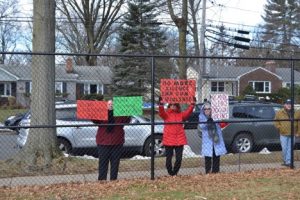
Along with student protesters, other Glen Rock adults joined in and made posters in support of ending gun violence.
On March 14, students all around the nation participated in their own local school walkouts to protest against gun violence. This has shown to be the main platform of speaking out for students and teachers. At Glen Rock High School, the walkout began with an assembly. All the high school students packed into the gymnasium. As the five sets of bleachers filled up, students began to lean on the walls and find spots on the floor. Teachers Kathleen Walter and Christopher Pohlman stood up and talked about the history of protesting. All of the sudden, Jean Walter, a senior at Glen Rock, stood up and announced the commencement of the walkout. In her mind, she reminded herself of what she was protesting for. Jean’s parents are both teachers. She thinks about her parents and her sisters, who are also both in high school. After Parkland, it made her think of how her life revolved around school and that her school could be next.
Jean Walter and Casey Bedwell Coll lead the group of students choosing to protest outside and onto the football field. I scanned the area and noticed the large scoreboard at the back of the field. On the clock read seventeen minutes; seventeen minutes for each of the Parkland shooting victims. Walking along the field, my peers and I took notice of the policemen and cars, and the weapon we were protesting against holstered on their belts. The body of students made their way to the front of the bleachers and focused their attention on the six students that faced them. I saw an opportunity for a picture and cautiously made my way onto the bleachers above the students. Looking down and around at my peers, the reality of what I was doing hit me. We live in a small town where personal business is never personal. I’ve known most of these kids my entire life. What would happen if one of them died? I realized then how important protesting was and the part I played in the movement. My participation did matter.
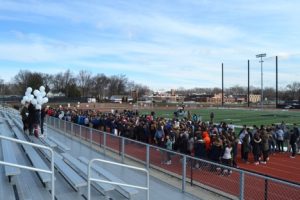
I carefully made my way down the bleachers and joined the rest of the crowd. The students on the bleachers each took a turn explaining what they were protesting for and emphasized the importance of what we were doing. Next, the names of each of the victims at Parkland were read aloud as a white balloon was released after each name was called. After a moment of silence was given, the clock reached zero and the students made their way back toward the school. I was at the tail end of the crowd when I turned my head and noticed the bright signs near the gates behind the bleachers. I ran to the fence and read the signs these three adults were carrying. This small gesture was another shining moment as I realized that this was a real protest. We were a part of something big that will live on and continue. I quickly took a photo and ran back to join the crowd.
After we were inside, classes resumed and the normal school day went on. I was confused at first because I thought more things should have been done, that we were just forgetting the entirety of what we had just done. But I then realized this is exactly what we were protesting for; a peaceful school environment.
To acquire a concealed weapon license in the state of Florida, requirements include that the individual must be over 21, be able to show competence with a firearm, and be a US citizen. Many would think that possible reasons for illegitimacy would be previous felony charges, and that is correct. However, the convicting authority has the right to revoke the firearm ban if they seem so inclined. Once a permit is received, there are no requirements of background checks on private gun sales.
Differently in New Jersey, requirements are much stricter on gun permit acquirement. To possess a gun permit in New Jersey, one must go through a “complete background check with the New Jersey State Police and FBI, mental health records search, investigation by the local police, and fingerprinting.”
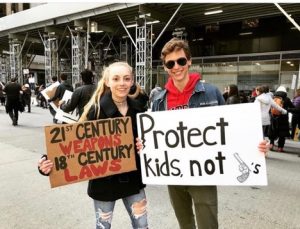
Glen Rock juniors Sarah Hutchins (left) and Matt Shiels (right) protest in New York City.
Change has been long awaited. Never again will America lose another child to such a senseless act if change is made. But the only way change can happen is through unity. We must put aside our prejudices and differences and come together to achieve the goal of overall safety. I shouldn’t be afraid to go to school or plan an escape route mentally in my brain for every classroom I’m in throughout the day. Jean Walter shouldn’t have to worry about her family’s safety at the commencement of every lock down drill. Zoe Petruccio should never have to feel the heartbreak of losing a friend at such a young age. Sam Schneider should never have had to look down his hallways and see rifles at every stop. He shouldn’t have to miss his classmates faces in the classroom.
The way we can have these nevers stay nevers is by you. You reading this article, whether a student or teacher or anything, none of you deserve to go through something this traumatic. Action is what sparks change. When I asked Sam why he got so involved in the movement, there was a long pause before his answer. Shakily, he admitted that it took some convincing. He didn’t believe at first that he would be able to be strong while also protesting. But he realized it was his duty to the families of the victims. Never again, he says, will another family have to lose someone they love.
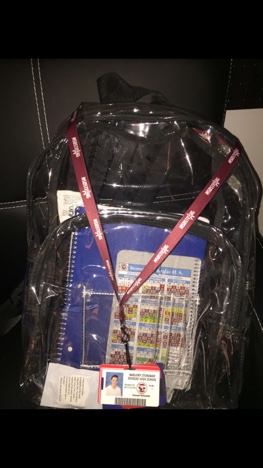
Parkland students must now carry around a clear backpacks
In memoriam for all the lives lost and of Nick, Zoe got a tattoo. She tells me that this was a big part of her life, something that won’t just go away and be forgotten. For Zoe, getting the tattoo solidifies the memory of that day and this feeling of grief but also the yearn for action. This shooting won’t be just any other, in which thoughts and prayers are sent but never backed up with the legislation and control laws that were needed.
Sam and I continued talking after our interview, and he told me that this article and others like it are exactly what needs to be done. Big news stations like CNN can capture the picture of these events, emotions, relationships, but to have news reached from a teen to other teens is extremely powerful.
“The CNN people, they went to school in different times… We’re the future. Not only do we have to get our voices out there but we have to show that like we are able to like we are capable of it. And you know like you and everyone else who’s writing articles are showing that we can,” Sam said.
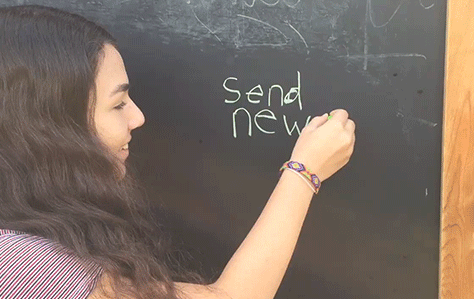
Rachel Goldberg is 16 years old and is a Junior at Glen Rock High School. She enjoys scented candles, inspirational tumblr quotes and taking long walks...



